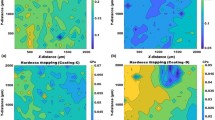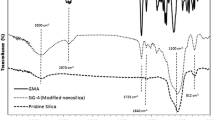Abstract
The influence of nano-silica with different particle sizes on inkjet paper coating was investigated. Laboratory self-made silica sol with particle size of 16 and 100 nm was employed as the pigment, and Polyvinyl Alcohol (PVA) was used as the binder. In order to study how nano-silica influences the properties of the inkjet paper coating, four groups of coating were prepared by variation of the dosage for two types of silica sol particle sizes. The viscosity of coating, the microstructure, physical properties, inkjet printing quality and dynamic permeability were characterized. The results showed that 16 nm silica sol could increase the viscosity of coating and reduce coating liquidity. Meanwhile, it did not contribute to the improvement of the physical properties and permeability of the coated paper. When the ratio between 16 and 100 nm silica sol was 30:70, the coated paper exhibited the best glossiness, smoothness and the solid density. In addition, it was found that the microstructure of the coating demonstrated good correlation with the performance of the coated paper.
Access provided by Autonomous University of Puebla. Download conference paper PDF
Similar content being viewed by others
Keywords
1 Introduction
The inkjet market shows an increasing growth, which necessitates the use for the inkjet printing process more developed strategy by taking small-scale color printing and low-cost variable data printing into consideration [1]. Inkjet printing is a non-contact technique with remarkable performances such as versatility, excellent long-term fastness, sharp detail rendering, and large color gamut [2, 3]. Inkjet print is demonstrated its potential application in electronics, 3D printing and biological materials [2, 4, 5]. Inkjet printing quality is dependent on the performances of inkjet recording materials, such as penetration and wettability, can primarily govern the setting and drying of the liquid ink on the surface of the material [5].
In recent years, silica-based nano-particles adsorbents have generated more interests due to their large specific surfaces area, high hydrophilicity and high porosity properties [5, 6]. However, silica particles aggregate easily, which leads to low solid content, weak stability of coating, and having low micro-porosity [7]. These structures affected the physical properties and inkjet printing quality. Therefore, in order to make inkjet printing’s lofty standards of flexible and reliable performance, the micro-porosity and dispersity of SiO2 particles have been studied [7, 8]. Wu prepared SiO2 coating modified by silicon coupling agent. It was found that the wettability and ink absorbency of modified silica coating was improved [8]. The properties of the coatings are greatly influenced by the particle size and pore structure of the coatings [9, 10].
However, there are few studies on the effect of nano-silica and its particle size on inkjet print coatings. In order to improve inkjet printing performance of the coating, silica sol of 16 and 100 nm were used as pigments. The influence of nano-silica on inkjet paper coating was researched by analyzing the viscosity of coating, the microstructure, physical properties, inkjet printing quality and dynamic permeability.
2 Experimental
In the experiment, the PVA was used as adhesive, and two kinds of silica sol (laboratory self-made) were used as pigments. The particle polydispersities of 16 and 100 nm silica sol were 0.132 and 0.101, respectively. According to the different proportions of nano-silica, 4 groups of coatings were prepared according to the experimental formulations. Table 1 showed the absolute mass ratio and number of each component.
The viscosity of coatings was measured by the viscometer (CAP2000 + , by Bokefei Corporation, USA). A scanning electron microscope (SEM, by Hitachi, Japan) was used to observe the microstructure of the coatings. The permeability of coated papers was measured by Dynamic Permeation Analyzer. The coating amount, smoothness, whiteness and glossiness were measured according to GB/T451.2-2002, GB/T 22363-2008, GB/T 7974-2013 and GB/T 8941-2007. The coating amount of papers was 6–7 g/m2. The solid density of inkjet printing was measured by density meter (518, X-Rite, America).
3 Results and Discussion
3.1 Viscosity of Coatings
As shown in Fig. 1, the viscosity of coatings was increasing greatly with the increase of 16 nm silica sol dosage. Therefore, too much 16 nm silica sol was not conducive to the preparation and pumping of coating materials. This behavior is possible because the 16 nm silica sol with smaller particle size, higher specific surface area and more silica alcohol groups than the 100 nm silica sol, the binding force between particles increasing, and the coating viscosity increase.
3.2 Microstructure of Coated Papers
The microstructure of coated papers from the SEM images was showed in Fig. 2. As shown in Fig. 2, C1 coated paper surface had relatively uniform pore structure formed by the coating, because the coating of 100 nm silica sol had good dispersion. C3 coated paper surface had non-uniform pore structure, and there were plenty of agglomerates on the coating. Since the 16 nm silica sol was filled in the pores between fibers, the uniform pore structure was hindered, and non-uniformity was formed due to the agglomeration of the 16 nm silica sol. The pores on the surface of C4 coated paper was large and uneven, because the 16 nm silica sol particles were too small to enter the fiber pores of the paper, and could not form a uniform coating.
3.3 Dynamic Permeability of Coated Papers
The dynamic permeation curves and permeation parameters of coated papers were showed in Figs. 3 and 4. The test liquid for dynamic penetration was water.
As shown in Fig. 3, dynamic permeation curves of C1, C2 and C3 coated papers showed an upward trend of obvious. The result indicated that the surface of the paper was uniform. The energy curve of C4 coated paper was upward trend of weak, which indicating that the paper surface was nonuniform.
Ci refers to the difference between the ultrasonic energy value from the 100% to the energy value, when the testing liquid penetrates the coating. Higher of Ci value means the more coarse-pored the coating, covering possibly worse. Ct refers to the time that the testing liquid strikes through the coating, start of the penetration into the base paper. The higher of Ct value means the thicker of the coating thickness.
As shown in Fig. 4, the value of Ci indicated that the pore size of the coating increases as the amount of 16 nm silica sol increases. The value of Ct indicated that the coating thickness of the C1 and C2 coated papers was thicker, and the C4 coated paper had the thinnest coating. Because the 16 nm silica sol would penetrate into the fibrous pores of the paper, and the smaller particle size silica sol was more hydrophilic.
3.4 Physical Properties of Coated Papers
The whiteness, glossiness, and smoothness of the coated papers were presented in Figs. 5 and 6.
As shown in Fig. 5, the whiteness of coated paper had a tendency to decrease, with the increase in the amount of 16 nm silica sol. The result indicated that the small particle size silica sol had a low whiteness, and the small particle size silica sol could not cover raw paper well. As shown in Fig. 6, the glossiness and smoothness of coated paper showed the same tendency, due to the correlation between glossiness and smoothness. C2 coated paper had the best glossiness and smoothness, while C4 coated paper was worst.
3.5 Inkjet Printing Performances of Coated Papers
As shown in Figs. 7 and 8, C2 coated paper had the best solid density, the solid density of C1 coated paper was better than C3 and C4. The result indicated that the inkjet printing quality of C2 coated paper was the best. Because C1 and C2 coated papers had uniform pore structure, which could fix the ink on the coating surface well. The coated paper, which was prepared by 16 nm silica sol, could not fix the ink on the coating surface well. Due to the 16 nm silica sol was filled in the pores between fibers, it was impossible to form a uniform microstructure.
4 Conclusions
The combination of 16 and 100 nm silica sol significantly improved the coating viscosity. The viscosity of the coating was increased by 16 nm silica sol, and the fluidity of the coating was reduced.
The combination of 16 and 100 nm silica sol had a significant influence on the microstructure, physical properties and permeability of the coated paper. The surface of coated paper prepared by 16 nm silica sol failed to form a uniform pore structure. Therefore, its physical properties and printing performance were the poorest. The coated paper prepared by compounding 16 and 100 nm silica sol with ratio of 30:70 showed the best printing performances in terms of glossiness and smoothness.
In conclusion, the well-constructed microstructure can improve the physical properties, printability and permeability of the coated paper.
References
Li, J., Ye, F., Vaziri, S., Muhammed, M., Lemme, M. C., & Östling, M. (2013). Efficient inkjet printing of graphene. Advanced Materials, 25(29), 3985–3992.
Singh, M., Haverinen, H. M., Dhagat, P., & Jabbour, G. E. (2010). Inkjet printing-process and its applications. Advanced Materials, 22(6), 673–685.
Badalov, S., & Oren, Y. (2015). Ink-jet printing assisted fabrication of patterned thin film composite membranes. Journal of Membrane Science, 493(12), 508–514.
Xu, T., Zhao, W., Zhu, J. M., Albanna, M. Z., Yoo, J. J., & Atala, A. (2013). Complex heterogeneous tissue constructs containing multiple cell types prepared by inkjet printing technology. Biomaterials, 34(1), 130–139.
Kettle, J., Lamminmäki, T., & Gane, P. (2010). A review for high speed inkjet coating. Surface & Coatings Technology, 24(12), 2103–2109.
Wu, J., & Jiang, B. (2012). A coating of silane modified silica nanoparticles on PET substrate film for inkjet printing. Applied Surface Science, 258(2012), 5131–5134.
Sowade, E., Mitra, K. Y., Ramon, E., et al. (2016). Up-scaling of the manufacturing of all-inkjet-printed organic thin-film transistors: device performance and manufacturing yield of transistor arrays. Organic Electronics, 30, 237–246.
Jiang, B., & Tao, P. H. (2014). Study of the adsorption performance and preparation of functional nano-silica pigment particles. Dyes and Pigments, 104(104), 169–174.
Liu, X., Chen, Y., & Zhang, Z. (2017). Influence of silica pigments with different sizes on the performances of coated ink-jet printing paper. Advanced graphic communications and media technologies, Lecture Notes in Electrical Engineering 417, https://doi.org/10.1007/978-981-10-3530-2_124.
Wang, Q. (2012). Effect of different particle sizes of silica on the microstructure of color ink-jet printing paper coating layer. Light industry science and technology, 28(03), 32–34.
Author information
Authors and Affiliations
Corresponding author
Editor information
Editors and Affiliations
Rights and permissions
Copyright information
© 2019 Springer Nature Singapore Pte Ltd.
About this paper
Cite this paper
Wang, H., Chen, Y., Zhang, Z. (2019). Influence of Nano-silica on Inkjet Paper Coating. In: Zhao, P., Ouyang, Y., Xu, M., Yang, L., Ren, Y. (eds) Advances in Graphic Communication, Printing and Packaging. Lecture Notes in Electrical Engineering, vol 543. Springer, Singapore. https://doi.org/10.1007/978-981-13-3663-8_93
Download citation
DOI: https://doi.org/10.1007/978-981-13-3663-8_93
Published:
Publisher Name: Springer, Singapore
Print ISBN: 978-981-13-3662-1
Online ISBN: 978-981-13-3663-8
eBook Packages: EngineeringEngineering (R0)












